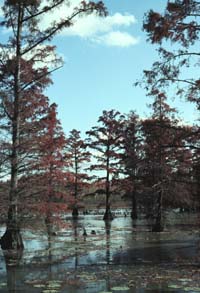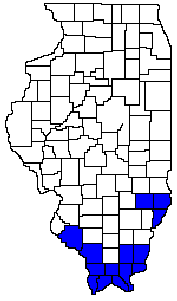 |
| Bald
cypress (Toxodium distichum)
Distribution
Map to Right |

Bald cypress is a large tree, reaching heights of 100-150 feet. It is also referred to as swamp cypress, southern cypress, and cypress. The base of the trunk is enlarged, frequently buttressed and surrounded by woody knees (cone-shaped structures that grow vertically from the lateral roots of the tree where the roots are at the soil/sediment surface). The crown is typically conical when the tree is young, becoming flattened or more open by branching when older.
In Illinois, bald cypress occurs naturally in swamps and low, wet woods in the extreme southern counties of the state. It also occurs in a few, localized areas in the southeastern portion of the state along the Wabash River. Mature bald cypress trees tolerate submergence, but the seedlings are killed by it. The seedlings must therefore become established during dry periods.
Interesting
Facts
Bald cypress is a deciduous conifer - it has cones and sheds its needlelike foliage. The leaves turn reddish-brown in the autumn when the twigs with the attached needles are shed. The only other deciduous conifer in the state is tamarack (Larix laracina).
Development of bald cypress knees was initially associated with the low oxygen environment in which the trees grew. The knees were interpreted to be an adaptive strategy to provide roots with oxygen under flooded circumstances. Experiments eventually demonstrated little exchange of oxygen between roots and knees. A more likely function of the knees is to provide stability in the swamp substrate.
Bald cypress trees are among the oldest in the state. Individuals can live to be up to 1000 years old. It is the state tree of Louisiana.
Identifying Features
BarkUses
Bald cypress bark is reddish brown to gray, fibrous, and peels in long shreds. The trunk is flared at the base and surrounded by knees on wet sites.
Twigs
The terminal twigs are slender and the new growth is very light green, gradually darkening and becoming reddish brown late in the season. The lateral twigs are also green, becoming reddish brown, but unlike the terminal twigs, they are shed with needles still attached in the autumn.
Leaves
The leaves are deciduous needles, alternate, and between 1/2 and 1 inch long. They are green, turning brown before they are shed. The male flowers are borne in branched clusters 5 inches in length and the female flowers are spherical and occur near the ends of the twigs.
Fruits
The fruits are cones with shield shaped scales, 1 inch in diameter, and occur on a 1/2 inch long stalk. They are green when newly formed, becoming purple with age, eventually disintegrating.
Bald cypress wood is durable and soft, lightweight, and close grained. It is used for general construction, railroad ties, fence posts, barrels, bridges, and shingles. The tree is planted as an ornamental.